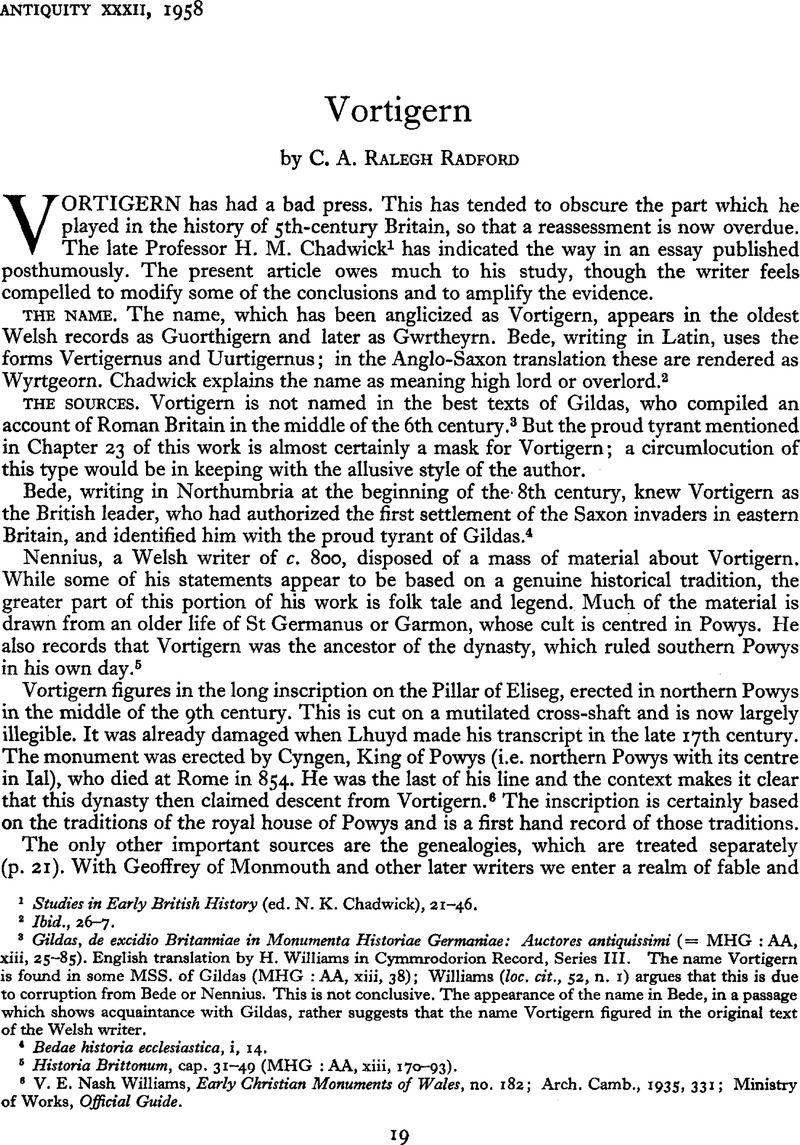
1 Studies in Early British History (ed. N. K. Chadwick), 21-46.
2 Ibid., 26-7.
3 Gildas, de excidio Britanniae in Monumenta Historiae Germaniae: Auctores antiquissimi (= MHG : AA, xiii, 25-85). English translation by H. Williams in Cymmrodorion Record, Series III. The name Vortigern is found in some MSS. of Gildas (MHG : AA, xiii, 38); Williams (loc. cit., 52, n. 1) argues that this is due to corruption from Bede or Nennius. This is not conclusive. The appearance of the name in Bede, in a passage which shows acquaintance with Gildas, rather suggests that the name Vortigern figured in the original text of the Welsh writer.
4 Bedae historia ecclesiastica, i, 14.
5 Historia Brittonum, cap. 31-49 (MHG : AA, xiii, 170-93).
6 V. E. Nash Williams, Early Christian Monuments of Wales, no. 182; Arch. Camb., 1935, 331 ; Ministry of Works, Official Guide.
7 Y Cymmrodor, ix, 152.
8 E.g. MHG : AA, ix, 586-735.
9 Bedae historia ecclesiastica, i, 15.
10 Y Cymmrodor, ix, 152-69.
11 Bedae historia ecclesiastica, V, 21 and the note in Plummer’s Edition, ii, 334.
12 The Cultures of Northwest Europe (H. M. Chadwick Memorial Essays), 245-57.
13 Historia Brittonum, cap. 49 (MHG : AA, xiii, 193).
14 Y Cymmrodor, viii, 83-92, pedigrees xiv and xviii; for date, ibid., ix, 142, n. 1.
15 Ibid., ix, 169-83, pedigree xxvii.
16 This is well brought out by Chadwick, loc. cit., 28 ; Historia Brittonum, cap. 42 (MHG. : AA, xiii, 186).
17 Arch. Journ., xcvii, 134.
18 R. G. Collingwood and J. N. L. Myres, Oxford History of England, i, 297-301 ; the archaeological evidence for this extent is now confirmed by imports of Argonne ware, which are concentrated in the southeast and in isolated instances reach north and west to York, Wroxeter and Cirencester (Chenet, La Céramique gallo-romaine d’Argonne, 147). To his list add Moel Fenili.
19 Arch. Camb., 1937, 97-9.
20 Arch. Journ., CV, 63-4; cf. Wheeler, Lydney, 63-5.
21 Historia Brittonum, cap. 32-5 (MHG : AA, xiii, 172-6).
22 Cf. E. G. Bowen, The Settlements of the Celtic Saints in Wales, 32.
23 K. Jackson, Language and History in Early Britain, 281 ; cf. Cymmrodorion Trans., 1946-7, 53.
24 Acta Sanctorum, Julii VII, 200-21 (31st July).
25 Historia Brittonum, cap. 39 (MHG : AA, xiii, 186).
26 Taciti Agricola, xviii.
27 Ptolemaeii Geographiae, II, iii, 18; cf. Archaeologia, xciii, 8, 25 and 40.
28 J. E. Lloyd, History of Wales, i, 119.
29 D. Atkinson, Report on the Excavations at Wroxeter, 1923-7, 177-84.
30 Ptolemaeii Geographiae, II, iii, 19.
31 Anglo-Saxon Chronicle, s.a. 605/6 (Rolls Series, xxiii, 38-9).
32 J. E. Lloyd, History of Wales, i, 242, n. 76.
33 Studies in Early British History (ed. N. K. Chadwick), 30-2 and 47; cf. Thomas Parry, A History of Welsh Literature (translated by H. Idris Bell) 1071, who quotes from the elegy on Cynddylan: ‘he went on foray beyond Tren to the presumptuous land’, commenting ‘he carried his attack beyond the river Tren (Tern in modern Shropshire), which was the boundary between Powys and Mercia’. The Tern is a tributary flowing into the Severn about one mile above Wroxeter.